A BRIEF ABOUT THE WESTERN UGANDA’S NATIONAL PARKS
1. BWINDI IMPENETRABLE NATIONAL PARK a home to the rare endangered mountain gorillas in Uganda, is strategically located at the edge of the western rift valley (Albertine rift valley), in South Western Uganda. It is shared amongst Rukungiri, Kisoro and Kabale Districts.

Bwindi impenetrable rainforest –is among those few in Africa that has flourished throughout the last Ice Age covering around 331 square kilometers with an Altitude Range that goes from 1160 meters in Ishasha gorge up to 2607 meters at Rwamanyonyi Peak. Having an annual average temperature Range of 7-20 degrees Celsius with its coldest period being June and July and experiencing its heaviest rains during March-April and September – November, Other months are usually dry.
The gigantic rain forest homes to over a half of the world’s mountain gorillas thus it is the major Uganda Gorilla safari destination to visit the endangered mountain gorillas. A deeper look into the inviting beautiful brown eyes of these gentle shy mountain gorillas on Uganda is unarguably the most exciting memorable Uganda wildlife tour encounter that Uganda and Africa at large have to offer coupled with Bwindi’s broad biodiversity that gives support to the Eco-Tourism industry as well.
With an altitude range of 1,160 to 2,607m, the national park boasts of 90 mammal species, including 11 primates, with the black-and-white Colobus, which is prominent for its beautiful flowing white tail to show which makes it a flourishing Uganda wildlife safari destination as well.
Bwindi with its 23 highly localized Albertine Rift endemics present, the forest ranks as one of the best birding tour/ birding safari destination in Uganda;
In Summary; Annual Precipitation: 1130 mm – 2390 mm, Coldest months/ period: June-July
Major tribes; the Bakiga; the Bafumbira with a few marginalized Batwa form the densest settlements in Uganda to the tune of 233 people/ square kilometers;
Special Species Diversity of Attractions;
Bwindi Impenetrable National Park habitates over 400 endangered gorillas which is about half the total population of mountain gorillas the world has, it has over 30 elephants and 120 species of mammals which include 7 diurnal primates. with 360 species of birds and 200 butterfly species, the Afro-montane rain forest has a dense under store of ferns, vines, and shrubs, and over 324 tree species recorded there, of which 10 don’t appear elsewhere in Uganda making Bwindi a must trek to any enthusiastic tourist or traveler.
Adventure Activities;
Gorilla safaris; Having 400 Mountain Gorillas, gorilla trekking tours & safaris form the major tourist activity/attraction in Bwindi. On daily basis two gorilla groups are usually available for tourists to visit. The Mubare group comprising of 16 gorillas with1 Silver back, this group was officially opened for tourism in 1993.The other group being the Habinyanja group which comprises of 23 gorillas with 2 silver backs and was readily opened in July 1998. The last and third group of gorillas comprising of 17 gorillas with 2 silver back, is yet to be open for tourism.
Note that;
- All gorilla tracking permits are sold by Uganda Wildlife Authority (UWA) at the Headquarters in Kampala with only 8 gorilla permits per day being sold for each of the 2 Gorilla groups. Advance booking- at least 3 months in advance is recommended to prevent missing out.
- The Gorilla tracking activity starts at 8:30 am local time and lasts the whole day.
- Gorillas are supposed to be met for only an hour once they have been tracked.
- The Gorilla Tracking activity in Bwindi is tedious in this regard tourists are therefore urged to be physically fit and carry jungle boots and rain jackets along with them because the forest is always wet.
The Bird watching safaris; As noted earlier, Bwindi is the best birding safari tour destination it’s a sanctuary to over 348 bird species that are impossible or hard to see in any many other part East African regions.
Among others, special on its list are; the honey guide, the Wing, White-tailed Blue Monarch Short-tailed Warbler, kivi ground thrush, Wilcock’s, Rusty-faced woodland Gruel’s Rush Warbler, Yellow-eyed black Fly-catcher, Warbler, Bar-tailed Trogon and Dusky Crimson An enthusiastic bird watcher can be able to identify as many as 100 species daily.
The Nature Walks; Visitors with two or more days in Bwindi impenetrable national park, can ably engage in a hiking tour along the four outland hiking trails that are famously done in the park. On all these trails, you will ably experience and get a educated about the various bird species, the primates, butterflies, the trees as well as the other members of this Eco system. It’s advisable that you arrange for a guide’s services and company from the reception for your safety and to attain an excellent understanding of the park’s entire Eco system.
The river Munyanga walk; A short walk for visitors with little time to spare along the forest edge offers tourist a memorable sight of birds as well as primates. This famous waterfall walk gives an attractive feature of the forest with a colorful array of butterflies, a natural fusion of tree ferns, epithetic ferns, orchids and colorful which is typical of Bwindi impenetrable forest. The walk leads to 3 attractive crystal clear waterfalls which is a typical ingredient of a tropical rain forest.
The Rushurra walk, gives an extensive view across the western rift valley floor, and to its west, the Congo Parc Nationale Des Virungas providing a wonderful view, and is also visible to both Lake Edward and Rwenzori Mountain as well. The Muzabajirro walk provides an unforgettable view of Bwindi Forest, the Western Rift Valley and the Virungas. Various pre-historic tree ferns can be witnessed as you make your way to the top, which is a great place for a picnic or lunch.
The ivy river walk: Mostly recommended for bird viewing for bird watchers, is the longest in the park and will take you a full day. Buhoma village walk, offers tourists eye catching views like those of a typical Ugandan rural homestead setting in this region, a visit to the local traditional healers, the banana beer brewing demonstration site, captivating traditional cultural performance in the evenings which are usually performed by Women groups provide the opportunity to experience the traditional dressing fashions as well. This walk that takes over three hours, is an activity that is managed by the local community thus money received is invested back into the community to improve on their general welfare usually. Visitors may as well walk to the Bamboo zone which is a unique area in Bwindi impenetrable national park.
The Bamboo trail walk; This leads to one of the areas of high diversity in the park that offers 14 vegetation types . At the pick of this walk, you will be presented with unforgettable views some of which include the L. Bunyonyi and Mafuga forest.
2. MGAHINGA GORILLA NATIONAL PARK only 33 sq km of size, is located in the far southwestern corner of Uganda bordering Rwanda and Congo,14 km from kisoro town in Bufumbira County about 540 km from Kampala-the capital. Mgahinga National Park was gazetted in 1991.

This Park covers the northern slopes of the three northernmost Virunga Volcanoes namely; the 3,474 m high Mt. Gahinga, Mt. Muhavura (4,127 m), and Mt. Sabinyo (3,645 m). The park is bordered to the south by the Republic of Rwanda and to the west by the Democratic Republic of Congo (DRC). Each of these surrounding countries protects its own share of the Virungas. The three parks together form the ‘Virunga Conservation Area’ ( VCA) totaling to 434-sq. km of which Mgahinga is 33.7 sq. km, just 8% of the VCA.
Mgahinga Gorilla National Park experiences two wet rainy seasons; February – May and
September- December of each year. The maximum amount of rainfall it receives in a year is 250mm-October and Minimum is 10mm -July.
Despite being the smallest in Uganda, Mgahinga Gorilla National Park is one of Uganda`s prime tour-safari destination very important to the country for it is one of the only two parks in Uganda that are habitat for about half the world`s endangered Mountain gorillas hence a Uganda Gorilla safaris destination as well as a great African Wildlife safari spot due to a large variety of wildlife such as buffaloes, elephants, bush bucks, the threatened golden monkeys just to mention but a few.
This park consists of the partly forested slopes of three extinct volcanoes. These huge cones of the virunga volcanoes dominate the landscape when viewed from a distance and front you as you approach the premises. When you get to the park, a 15 minutes’ walk up the viewpoint from Ntebeko Gate can get one a great overview of the area. Mgahinga Park is of a great biological importance because it’s one of those mountains that provided a refuge for mountain plants and animals that moved up or down the slopes as climate became warmer or cooler throughout the climatic changes of the Pleistocene ice ages. The Virungas are home to a large variety of wildlife, including about half the world’s critically endangered mountain gorillas.
The park experiences a cool climate that supports the growth of Afro-montane vegetation and the abundant type of Vegetation is the bamboo, a delicacy to the Mountain gorilla. The Lobelia, Haege-nia spp are among the other types of vegetation is park.
The major ethnic groups of people in Kisoro District are the Bafumbira who occupy most of Kisoro area and are majorly cultivators/farmers. The Batwa (Pygmies) who once lived in caves and fed on wildlife form the minority group in the area;
WHAT TO DO HERE:
Gorilla Tracking; The most thrilling tourist activity in Mgahinga Gorilla National Park is that of Gorilla Tracking safaris-tours. The Nyakagezi is the habituated gorilla in this park and it which consists of 9 members; 2 silver backs, 3 adult females, 2 juveniles and 2 infants.
Gorilla tracking is a vigorous activity that can take a full day. During this tour, you are led by a guide through the gorilla’s empire/tracks as he/she explains all about gorillas such as their ecology, movements and general behavior.
Please note: success of seeing gorillas is NOT guaranteed despite the high chance of seeing them. Since they are wild animals living in the jangle, they don’t have a fixed routine; therefore finding them requires luck and the experienced of your guides. These guides know gorillas intimately since they habituate them, they will hence take you to the area where they saw them last. They may also be able to suggest how long the hike might take at the journey start.
Please note that you are free to ask guides to slow down if they are going too fast or if you want to have a rest, look at birds /flowers, and your guide shall wait for u.
HIKING:–Volcano Climbing
Mt. Sabyinyo; (366m)
As locally known literally meaning ‘Old man’s teeth’ has an eroded Mt. Sabyinyo’s crown. This volcano offers 3 challenging peaks to expert climbers. Climbing up this mountain takes 0ne up a ridge along the eastern side of the climb to the first peak. If you want to continue, the climb to the peak 2 involves walking along a ridge with breath-taking drops into Rwanda and Uganda`s gorges, a life time memorable dual hiking safari experience one can only achieve here in the world!.
Finally, the hike up to the steep peak 3 steep that has several ladders and mush scrambling, here you are guaranteed to get your hands dirty en-route to this peak. Once on top, you will be in three countries; Rwanda, Democratic Republic of Congo and Uganda at the same time!!, yet an exclusive experience to only this destination. This hike takes about eight hours to cover the 14km stretch round trip.
Mt. Gahinga; (3474m) This Mt`s name (Gahinga) literally means a pile of small stones according to the native people. On your way to Mgahinga National park, these small piles of stones are visible in the garden fields.
Mount Gahinga is reasonably bigger than the average ‘gahinga’ but her proximity to Mount Muhavura makes her look small. This trek that takes you about six hours round trip, goes through a good sample of a pure Bamboo forest. Mt. Gahinga had a Crater Lake on top some time past, but this has changed into a Lush swamp. This 8km Distance swamp is one of Gahinga`s attractions.
Mt. Muhavura; (4127m) (as called by natives literally meaning ‘The Guide’)
This mountain is seen from all over Kisoro and it acts as a guide. This typical cone-shaped Mountain provides some of the best views in the country. Much of the climb traverses a rocky surface covered by short grasses and small shrubs. Once hikers reach the top, they get rewarded with the view of the Virunga volcanoes, Lake Edward in queen Elizabeth National Park, Bwindi and the Rwenzori Mountain peaks. This 12km hike takes approximately 8 hours all rounds. Hikers are advised to camp at the Muhavura base camp the night before, the site has no facilities so one needs a tent, personal water, food and sleeping equipments.
CAVE EXPLORATION
Garama cave; This cave is 342m in length and 14m deep, long ago, in this cave lived the crafty Batwa people who were warriors as they pursued their neighbors but now inhabited only by bats, From the park head-quarters to the cave entrance, is 3 km long and it takes about 4 hours. Your guide will narrate to you how the Batwa lived and made their attacks out of the cave.
Viewing Platform; This point is about 800 meters from the Park gate. Once one gets to the top, you will be rewarded with a good view of the Park and the surrounding environment. The activity is free and doesn`t require a guide. Information about this spot can be gotten from the displaying panels at the hill point.
Border Trail; – Visa Not Required. This 5 hours hike covers 10km a distance. It takes you first toward Sabinyo and climbs up the base of Sabinyo for a while through fine Montane forest before turning toward the Congo. Along the trail you will get a great view of Mt. Sabinyo’s gorge and peaks. When you get to the Congo you get back along the international border. The route back to the Park Head Quarters is a great section for birding with a wide range of bird species. There are 2 rest huts along the way that are good places for taking a break. Common on the same route are the golden monkeys and elephants.
Birding;
Mgahinga Gorilla National Park is a prime birding safari-tour spot in Uganda blessed with 79 unique bird species that have been recorded within the park, these include several species endemic to the East Congo Montane region.
Over 295 species have been recorded in the Virunga Conservation Area as a whole and are endemic to the Albertine Rift Afro-montane region representing 59% of the region`s total of known endemic species.
Please contact the Park Management for a guide who will take around and tell you all about these birds. Ensure you carry binoculars for the best view!!!
Free Birding; Now available on request is free birding along the edge of the park. The guides are always happy to take you out from 5-6 pm (in the evening) if you book by 10:00 a.m. the morning of the day you wish to go for this activity. You have a choice to go for a long walk or simply relax in the campground. If one takes the long buffalo wall toward the Congo you get to a wetland area where you have a splendid view of a wide range of birds such as Fire Finch, Stonechat, Grey Capped Warbler, Ibis, Whydah, Speckled Mouse bird, Waxbills, and Yellow-Vented Bulbul. Do it at your own pace-relaxed and your guide can show you the best spots are.
GETTING THERE;
By road: From Kampala; It’s an 8 hours drive via Kabale to Kisoro town using 4wd cars as recommended. For those without private transport, one can take the daily bus transport services that set off at 0700 hours. From Kisoro town, you hike or take a special hire vehicle to the park gate.
By Air: One can fly to Kisoro; Flight arrangements can be made with Eagle Air. This company has flights on Mondays and Fridays from Entebbe to Kisoro.
3. KIBALE NATIONAL PARK-the major Chimpanzee trekking safari tours destination in Uganda, is located in Kabarole district of western Uganda near Fort Portal and measures 776 sq km in size. It is elevate between 1110 meters to 1590 meters and has a national park since 1993.

It is the most accessible of Uganda’s major rainforests and home to 13 primate species, remarkable of which are the very localized red colobus and L’Hoest’s monkey. 77% of Kibale National Park is covered by a medium altitude, moist evergreen forest in the north, and a medium altitude moist semi-deciduous forest at lower altitudes in the south. The remaining 23% of the park is composed of savanna grassland, swamps and some plantations with exotic coniferous trees.
The Batooro and Bakiga are the main native traditional tribes lived in this area to date. These tribes utilize the forest for food, fuel, building materials and medicines.
Tourist Activities
Chimpanzee tracking: The major tourist attraction in Kibale is the opportunity to track habituated chimps. These delightful apes, more closely related to humans than any other living creature, are mesmerizing to watch as they freely squabble and enjoy their play in fruiting trees with in the forest.
Kibale has a highly successful customary Chimpanzee-tracking program. More primates may be found on these guided walks that include Olive baboons, the grey-cheeked Mangabeys, the blue L’Hoest’s gentle, Guereza colobus, and Red-tailed monkeys usually found in open areas close to the forest. You may also find Elephants, Hogs and Bufalloes along the way. Bush buck, Harvey’s and Peter’s duick-ers are yet other inhabitants of this forest.
Night guided walks are also worth an adventure.Here you are fronted with special animals such as the Lord derby’s anomalure, Potto, Thomas’s Galagos, Spectacled Demidoff’s, Common Genet and African Civet.
Other interesting mammals from the list of over 60 species include Banded and Marsh Mongooses, Ichneumon, , Swamp Otter, Alexander’s Cusimanse, Ratel (Honey Badger) and African Palm Civet. Although Golden cat, Serval, Lion, Leopard, Warthog, Giant Hog and Hippopotamus are recorded from the park, they are unlikely to be encountered in the Kanyanchu area. Sitatungas are known from Bigodi swamp but are infrequently seen. The spectacular and beautiful Rhinoceros Viper is fairly common here but is, unfortunately, less often found alive than as a road-kill.
With over 60 species, other interesting mammals include the Alexander’s Cusimanse, Banded and Marsh Mongooses, Swamp Otter, Ichneumon, Ratel /Honey Badger and African Palm Civet. On a lucky day, one can see the Lion, Leopard, Golden Cat, Warthog, Serval, Hippopotamus Giant Hog and the rare Sitatungas commonly found in Bigodi.
Kibale National Park offers affordable 3 hour chimp tracking limited to a group of 6 people that leave for their tracking at 8:00 am and 3:00pm daily. The popular night walks depart from Kanyan-chu visitor Centre at 7:30 pm but carrying a personal touch and advance bookings are highly recommended.
Bird watching: Kibale`s network of shady forest trails provides much delight to botanists and butterfly lovers. With 335 species recorded including the endemic Prirogrine’s ground thrush, birders are greatly impressed. Her bird species include; the Grey-winged Robin, White-naped Pigeon, Red-winged Francolin Green-brested Pitta, Uganda Woodland Warbler, Chestnut-winged Starling Red-chested Flufftail, Abyssinian Ground Thrush, Grey-throated Flycatcher , African Pitta, Joyful Greenbul, White-bellied Crested Flycather, Uganda Woodland Warbler, Masked and Black-capped Apalises Chestnut-winged Starling, Grey-headed Olive-back ,Orange-tufted and Tiny Sunbirds, Uganda Woodland Warbler and Chestnut-winged Starling.
When To Trek Chimpanzees In Kibale Uganda March – May, September – November
4. SEMULIKI NATIONAL PARK is impeccable a Uganda safari spot located in the extreme west of Uganda in Bundibugyo district along geo-graphical coordinates 0o 44′- 00 53′ N – 290 57-30o 11’E. It is an eastern extension of the vast Ituri forest, and forms part of the forest continuum during the climatic upheavals of the Pleistocene period. It forms one of the richest areas for both flora and fauna in Africa particularly birds.

It lies within the western arm of the East African Rift Valley along the Uganda/ Democratic Republic of Congo (DRC) border. Semuliki National Park is bordered by the Rwenzori Mountains to the southeast , to the west is the Democratic Republic of Congo, to the north are the Semuliki flats and Lake Albert further on.what an interesting view all round!!!
This 220 sq km Semuliki National Park, one of the newest national parks in Uganda was gazetted in October 1993. Her land form includes a flat land form with a gently undulating park that ranges between 670 -760 meters above sea level. Many areas in this park flood up during the rainy season because all streams and rivers from the surrounding area drain through the park, coupled with the poor topography and drainage.
The average annual rainfall in Semuliki is 1,250mm with March-May and September-December as the pick season. Her temperatures range from 18oc to 30oc but these have relatively small daily variations.
What to do:
Species Diversity
Semuliki National Park is a lowland tropical rain forest hence moist and semi-deciduous. The park has 336 tree species recorded, 24 of which are restricted to only Semuliki, to the eastern part of the range, only shared by one or two neighboring forests some of which are Nesogordonia kabingaensis, ejacis guineesis and Isolana congolana. Some tree species such as lovoa surymertonii and cordia millenii are considered to be endangered in Semuliki National Park.
Compared to other exceptional diversity for small mammals, birds and butterflies, among the fauna recorded in Semuliki include 435 bird species which is about 34% of Uganda’s total. Some of these cannot be found anywhere in East Africa and are the continent’s most spectacular and sought after birds; the horn bills and lyre tailed honey guide just to mention but a few.
Semuliki National Park is unique Uganda wildlife safari destination because it has 63 mammal species, 9 of which are diurnal forest primates such as chimpanzees, olive baboon , blue monkey, and vervet monkeys, while the nocturnal primates include galagos plus pottos . To add to her mammals species, Semuliki National Park has forest beecroft’s flying squirrel, buffaloes, little collared fruit bat, blue duiker, pigmy squirrel plus the water chevrotaain.
About 374 species of butterflies and months have been identified in semuliki 46 of which are forest swallowtails and charaxes and at least 81 species of large moth, 12 of which are classified as restricted.
The forest’s location, but also to the varied habitats, forest swamp, grassland and an extensive system of hot springs, warm swamp and Savannah woodland accounts to her wide range of species.
Local People
Four ethnic groups live around Semuliki National Park. The Bamba and Bakonjo are found in the valley and mountain slopes respectively, and are majorly agriculturalists depending on cash crops such as rice and potatoes coffee, cocoa and food crops mainly bananas.
The Batuku people occupy the rift valley floor, north of the park and are pastoralists who depend entirely on cattle products which they trade in with their neighbors, both Ugandans and natives of the Democratic Republic of Congo.
The Batwa /pigmies who are gatherers and hunters form part of the Ituri ethnic group, who have since time immemorial depended on Semuliki forest for survival. However their lifestyle is now changing due to daily interaction with other neighboring local communities and the impact of tourism.
Tourist Activities
The Semuliki National Park jungle life is a breathtaking one especially for birding tour, primate, butterfly and plant lovers. Her nature walk stretches you up to the meandering river Semuliki, the only one of its kind in East Africa.
On this tour, a list of potential forest animals one may see include; leopards, buffaloes and elephants, sitatungas, various primates, crocodiles, and a variety of water and forest birds.
Sport fishing;
Interested visitors should carry their fishing gadgets for sport fishing along the river. The Semuliki National Park safari has splendid and breathtaking views that have life time memories to offer. Come and experience the thrilling winding Bundibugyo road through the Rwenzori escarpments. Along the way in the mountains, you will enjoy scenic views of the meandering Semuliki River, fuming hot springs and the buttress tropical tree rain forest that stretches to Ituri forest in the Democratic Republic of Congo.
Situated in a tract of hot mineral encrusted swamp land are two hot springs, Here you will see a two meter jet of hot water about 30oc and a 12m diameter pool of oozing boiling water about 106oc. To the surprise of many, you can boil food in the natural boiler (the boiling pool) within 10 minutes and eat it especially eggs. Why not have this trip and have this fascinating experiment a practical trial? You had better; you will live to remember it!!!
A trip to the nearby protected areas like Rwenzori Mountains National Park, Kibale National Park and Toro-Semliki wildlife Reserve can be arranged for a guest.
5. RWENZORI MOUNTAINS NATIONAL PARK: A Uganda Safari that features the Rwenzori mountain climbing adventure provides a memorable and rewarding experience but in order to have a smooth flow it should be well planned and every tour must be well prepared. The central hike circuit can take about six nights/seven days and then reaches an altitude of 14,000ft (4,267m) above the sea level.
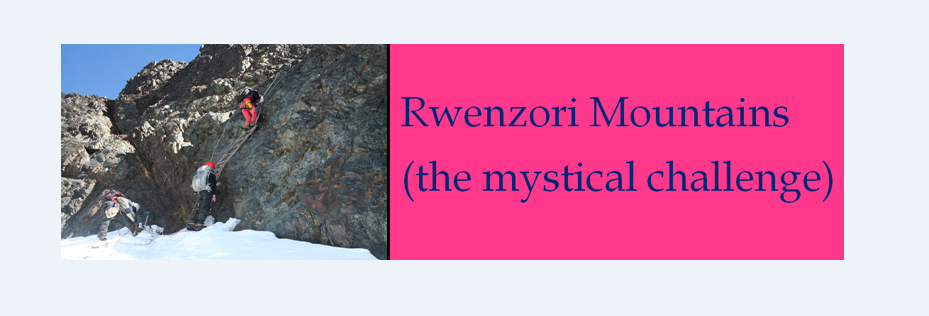
Conditions on this mountain are quite challenging even to an experienced hiker as mountain Rwenzori is well known for its steep, unengineered, and slippery trails with frequent rainfall and cold temperatures, fog, muddy, steep terrain with a high altitude.
Despite this it’s worth a try due to the exciting experience you will attain. Its dry period includes July-August, December-February and so its relatively dry for inexperienced hikers.
At all seasons its recommended that one should have a rain gear, a good sleeping bag, a warm hat, pairs of gloves, heavy socks, gum boots, gaiters and a walking stick for easy balance and support are plus a basic first aid kit.
Porters stay around the mountain thus help visitors carry their heavy equipments and food, leaving one with a small pack, rain gear, warm clothes, camera, water and any other light luggage for an enjoyable experience.
One can purchase their own food and Rwenzori mountaineering service can provide cooking utensils and cooks to help in preparing it.
Central Circuit Trial
Day 1: Ensure that you arrive at the Rwenzori Mountaineering Services (R.M.S) & Rwenzori Mountains National Park offices located at Nyakalengija during morning hours in order to have enough time to hire hiking equipment and get booked for services of porters guides.
Hiking activities are set off from 5,400ft/1,646m at the park headquarters going past typical the Bakonzo “mud and wattle” homesteads. Gradually continue walking through the huge elephant grass upwards and via garden plots which takes about 40minutes to arrive at the boundary of the park.
This trail follows river Mubuku crossing through recent landslide areas that involve climbing over rocks and a bluff, before reaching river Mahoma within 2hrs 30min time. After crossing this river embark on a steep climb through the open bracken fern slopes & Podorcarpus Forest at 8,700ft (2652m) up to the Nyabitaba hut.
Climbing from Nyakalengija area to Nyabitaba takes an average hiker about 5-7 hours and the total elevation attained is 4,000ft (1,200m). Slow or armature hikers could take a much longer time, it is therefore advisable to set off from the park headquarters as early as possible to avoid trailing in darkness.
During this trip, you might hear chimpanzees sounds and might get a glimpse of the black and white colobus, blue monkeys plus the beautifully Rwenzori Turaco bird.
Day 2: For half a kilometer the trail starts at Nyabitaba Hut-West wards then drops steeply heading to the Kurt Shaffer Bridge. It cross below rivers Bujuku & Mubuku respectively and after turning on the right of the bridge, starts climbing up the central circuit anti-clockwise since the opposite direction is more demanding and risky.
The muddy slippery trail goes consistently up through a bamboo forest after the Kurt Shaffer Bridge,. After 1:30hrs, you will get to the most challenging and dangerous footing of the whole circuit according to many hikers. Since it has slippery boulder hopping;
You will reach out to the Nyamuleju hut with its accompanying rock shelter after 5hrs of walking from Nyabitaba and this may be a great stop over for yo night. This is the start of the giant groundsel zone and Lobelia, a unique vegetation type found no elsewhere in the world, except at Rwenzori.
You will have a 1hour walk through a challenging bog to John Matte hut (11,200ft/3,414m). It is full of unique plants and the slow pace at which one walks is a delightful chance to examine and photograph the unique environment. Reaching john matte takes 7 hours. To some hikers this is the most tiring and longest day of the entire circuit so an early start is recommended.
Getting on top of this altitude-Kurt Shafer Bridge means one is about 3,000ft (915m). Hikers who feel have reached their height limits at this point should consider stopping here.
Day 3: You will leave John matte to cross the Bujuku River to enter the lower Bigo bog, and you shall experience jumping from tussock to tussock on a grassy bog. This trail is not only muddy but follows the left (southern) edge of lower Bibo bog until it finally reaches the round metal “uni-port” the bigo hut and its rock hard shelter.
There is a steep section past the hut that leads to the upper Bigo bog, in the last half of which, a boardwalk has been constructed. Someone may think it is an ugly intrusion, but it makes walking easier and prevents hikers from further damaging this bog. At the upper end of this bog is a beautiful narrow stream that can make a lovely stop over for your lunch.
6. LAKE MBURO NATIONAL PARK
With a size of 260 sq km, Lake Mburo National Park is situated near Mbarara district and forms Uganda wildlife tours and Safaris destination best for tourists to amazing wild game walks amidst chanting and grazing wild animal and this can be done here in the whole Uganda .

It Lies in the one part of Uganda that is covered in extensive acacia woodland and unlike any reserve in Uganda, L. Mburo National Park is home to remarkably different fauna. It is Uganda`s prime tour and safari destination for one to see the gigantic eland antelopes, zebras, topis, impala, and buffaloes. Its unique acacia-associated bird species population includes the rare Shoebill stork.it’s sculptured landscape with rolling grassy hills and beautiful lake shores has are harbors forest galleries, rich acacia tree valleys, seasonal and permanent swamps a combination of which supports a great attraction of different wildlife species.
One can have a great Uganda National Park safari or tour here because there five lakes within Mburo, it is home to hippos, crocodiles and a variety of water birds, and its fringing swamps are a hide out for secretive papyrus animal species such as the sitatunga antelope plus red/black and yellow papyrus gonolek. In spite of it being the smallest of Uganda’s Savannah national parks. Its mosaic habitat: dry hillside, rocky outcrops, bushes, thickets, open and wooded Savannah’s, forests, Mburo gives a lasting impression/adventure to all tourists that visit it.
It is about 3.5 hours drive from Kampala. The park is accessed from the Masaka-Mbarara road; turn left to Nshara gate (13 kms past Lyantonde) which brings you through Sanga gate. Both junctions have clearly marked signposts, it is about 13kms from Sanga trading center to Sanga gate and 8kms from the main road to Nshara gate. It’s an ideal Uganda safari destination for short tours and excursions. It is about 20 minutes drive from either gate to Rwonyo park headquarters.
TOURIST ACTIVITIES:
Game Viewing: Lake Mburo national Park is famous Uganda tour destination for it is richne in biodiversity and has about 68 different species of mammals. The common ones being the herbivores; Zebra, Impala, Buffalo, Topi, and Eland never the less, the rare slightly of Roan antelonkspe and leopard, Hyenas and jackals as predictors;
Birding: L. Mburo National Park is a magnificent birding safari destination on top of her large animals; she has a variety of colorful birds. For many bird lovers, birds are the most interesting creatures to watch in Mburo. This park is home for more than 315 different species of birds including; the rare shoebill stork, African fin foot, saddle billed stork, brown chested wattled plover papyrus yellow warbler, Olea species and Boscia, abyssinian ground hornbill and white winged warbler, curruther’s cisticola, tabora cisticola, great snipe and other Acacia bird species.
As common species become familiar, one will begin to notice smaller, less spectacular birds. Real experts seem to get most excited by the ‘Little Brown jobs’ which are the hardest to identify. Although many birds are wild spread, some are fussier in their choice of habitat. Most of the park’s 310 recorded species are ‘generalist’ and can be viewed almost everywhere in the park. But there are notably 5 species of bird found only in the forest, and 60 specialist water birds. Others have preference for short or tall grasslands hence found mainly in woodlands.
Lake Mburo National Park has the following bird categories; Open water birds, Lakeshore and papy-rus swamp birds, Seasonal swamp birds, Woodland birds, Grassland birds and Forest birds. Her birds of the Open Water in this Park include; Pink-backed pelican, Darter, White pelican, Yellow-billed duck, Long-tailed cormorant, White winged black tern and Greater cormorant
Boat cruise: Lake mburo National Park is blessed with a diversity of animal and plant species that can only be clearly viewed if you take a boat cruise. To mention but a few, are crocodiles, hippopotamuses and birds like Pelicans, Black crake, Heron, cormorant, fish eagle, one may also sight the rare shoebill stork and all these are worth furnish one`s Uganda safari with pride. For any tourist, the presence of Lake Mburo within the park is a blessing with a lot to offer. The duration of each boat cruise is negotiable but it usually takes 2hrs and arrangements for extra time can be made with management at an extra fee.
Guide nature walks: The nature trail offers the visitor a chance to admire unique nature insights. In company of an armed guide, visitors have the opportunity to walk in the circuit at their personal choice pace. Comprehensive information about this trail is fully given to you in form of a brochure in both English and Runyankole at the trek/walk start.
Salt Lick: A walk to the nearby salt is the pick of the Mburo Uganda tour. Standing at the strategically located wooden hide (Observation point) offers visitors a chance to see at least 4 different species of animals at any one time as they lick the salty soil. Most interesting at this point is that the animals are viewed without their conscience hence they are not destructed from the salt lick. Visitors may also walk to a desired area but- under watch of an armed guide.
Rubanga Forest: With over 40 species of birds recorded in Rubanga, One can also explore this forest by making arrangements with the park management to have a ranger accompany you. Rubanga Forest is very small but a true forest with a closed canopy in place. The forest has unique trees common among them, are the Markhamia platycalyx (grey-brown truck) with irregular flaky patches, divided leaves, yellow flowers stripped and spotted with red; brunches of extremely long (up to 1.3 m pod like fruits). Palms, figs, sapium (a tall tree whose leaves turn red before falling) as well as the flame tree Erythrina abyssinica located towards the edge of the swamp.
Conservation Education Center: The park has a conservation education center, just about 1(one) Kilometer from Sanga gate and its open to interested tourists. With a descent accommodation and a 40 people occupancy hall, this center caters for individual visitors, school groups, for tourism, seminars and workshops.
Fishing: With about 6 species of fish, the common one being Tilapia (oreochromis leucostictuss) Lake Mburo is a dream spot for tourist interested in fishing;
Visitors planning to have sport fishing safaris on this lake should have their own fishing equipments and fish at only the designated point at Mazinga. At the campsite a restaurant is available to ensure maximum relaxation for visitors while at the lake enjoying their fishing.
Interpretation Center: Literature about the Park history, biodiversity and other resources including the scenic beauty is always available at the interpretation Center (The interpretation center is located at Rwonyo hill), which also serves as a starting point for nature walks.
7. QUEEN ELIZABETH NATIONAL PARK: Located in the southwest of Uganda near Kasese, covering 1978 sq km. Queen Elizabeth National Park (QENP) is Uganda`s most popular and accessible savanna reserve and Uganda safari destination. It was declared as a bios-sphere reserve purposely to harmonizing human activities with the conservation and protection of wild life , wet lands and natural resources in 1979.

QENP is bounded by the Ishasha River and Lake Edward to the west along DR Congo boarder, by Kasese and Rwenzori foothills to the north, to the east by lake George, kyambura/chambura gorge and kalinzu forest reserve, and by the Kigezi Wildlife Reserve to the south.
Much as QENP is primarily known for open savanna,in some areas studded with a dense cover of acacia and euphoria trees but it also embraces large area of thick swamps around Lake George,the extensive Maramaganbo Forest in the southeast, and the forested Kyambura Gorge along the border with the Kyambura Game Reserve .
Endowed with at least ten crater lakes within the park, including the highly accessible cluster right north of the main road to Mweya safari lodge, as well as the whole Ugandan shore of lake Edward,the western and northern shores of lake George, plus the connecting Kazinga channel QENP has a lot to offer to any tourist and a one of Uganda`s Eco tourism destinations. What a life time memorable site it is!.
Having been protected as the lake George and lake Edward game reserve since the late 1920s, the present day QENP was gazette as Kazinga National Park in 1952, purposely to protect landscapes of prolific wildlife typical of the Rift Valley flow from lake Edward to the Rwenzori mountains. In 1954 it was renamed QENP in memory of the Queen of England’s visit to this place.
With a total of 95 mammal species recorded here and the highest for any Ugandan national park, it makes this park a remarkable Uganda wildlife safari spot. These include ten primate species, including chimpanzee, black -and- white colobus and olive baboon, the vervet blue, red-tailed and L’Hoest’s monkeys, and around 20 predators are native to this park, the side-striped jackal among, the spoted hyena, lion and leopard, the beautiful Uganda kob, bushbuck, topi and Defassa water bucks- all antelope species. In her papyrus swamps around lake George duels the elusive semi-aquartic sitatunga antelope and four duikers species are resident in Maramagambo Forest. Buffaloes are common sight and are usually redish in colour due to interbreeding with the Congolese forest redder forest buffalo.
Today, QENP boasts with around 2500 species of Elephants and with at least 200 readily observed Lions. This park is home to 610 species a remarkable aspect for a reserve of her size basing on continental standards which explains why it is Uganda`s leading wildlife tours-safari destination. In addition to her 54 raptors, this park has virtually every water bird species found in Uganda, as well as a variety of woodland and forest birds, the later largely confined to maramagambo forest.
Birding safaris-tours are common here because QENP has a variety of bird species that majorly include; Open-billed Stork, African Jacana, Malachite and Pied Kingfishers, African Skimmer, Grey-headed Kingfisher, Grey-capped Warbler, African beautiful Black-headed Gonolek, Swamp Fly-catcher, Pin-tailed Whyda Martial Eagle, Black-rumped Buttonquail, Common Squaco Heron, Shoebill Stork, African Fish Eagle, African White-tailed Lark, Verreaux’s Eagle-Owl, Collard Pranticles, Gabon and Slender-tailed Mourning Dove, The Nightjars, Great and Long-tailed Cormorants, Black Bee-eater, White-winged Warbler, Papyrus Gonolek, Great white and Pink-backed Pelicans,Papyrus Canary, White-winged Terns.
The ethnic groups virtually attached to this area are; Banyankole, Bakiga, and Bakonjyo. These carry out a variety of traditional and contemporary economic activities-notably salt mining, crop and animal farming, and have a greatly reach diversity of dressing codes as well as languages, an interesting discovery to interested tourist.
With such a fusion of attractions I can strongly assert that QENP is a wonder tourist destination that has a lot to stain a life time memory of a great Africa tour-safari in to the minds of any great traveler/tourist.
TOURISTS ACTIVITIES AND ATTRACTIONS
Game Drives: An experience of this game drive in Q.E.N.P will automatically get you an exciting Uganda adventure to tell the rest of your life there is to live!.This involves driving through the park so as to view animals. It is best done in the early morning and late afternoon hours when the weather is calm. QENP has well-maintained tracks, giving visitors quick access to the park’s wildlife and other attractions.
These tracks cut through the mating grounds of the great Uganda Kob as the outstanding gigantic forest hog is seen moving around the park bush. You will enjoy a memorable sight of Elephants as they make their way down to the waters during hot days, hungry lions looking for their prey while bush backs and buffaloes can be found on the channel track and juxtaposed circumference.
The out unique panorama along the crater track leads you to volcanic craters at the foothills of the misty mountains of the moon, outstanding of all, the great overlooking Mt.Rwenzori shall be seen.
The Launch Cruise: This is a boat trip along the hippopotamus crowded banks of Kazinga channel and it gives you a unique unbeaten wild life experience. Crocodile are a common sight and occasionally a common leopard can be seen. Many buffaloes rest in the waters while big herds of elephants enjoy them-selves drinking and playing along the channel banks. You will See Hippos as surrounded by vast numbers of migrants and resident birds, this boat cruise puts one, right in the heart of amazing nature.
Nature Walks: In Maramagambo Forest; these are short to long guided nature walks offered at the great Q.E.NP. This will expose you diversity the wild; the pythons in the ostracism of the bat caves floor with their prey-the bats. This bat’s cave is near the attractive blue lake and hunter’ cave; Other trails lead you to the heart of the surrounding craters and habitats to many forest birds as well as some primates like the Chimpanzee.
A Nature Walk to The Kyambura Wild Life Reserve: It is found in the eastern part of the protected area and supports similar mammals to the rest of the park. It harbors three saline crater lakes, which attract a large number of flamingoes- not found anywhere else hence a great birding safari destination in Uganda. This steep Kyambura gorge, formed by the turbulent waters of the roaring Kyambura River, provides a luxuriant Riverine forest, habitant to Lions, chimpanzees.
Black -and – white colobus monkeys, olive baboons and other primates as well as plenty of forest birds, snakes and many others; A visit to the gorge presents a great opportunity to see chimpanzees in their natural habitat.
The Ishasha Visit: This trail to southern part of the park will let you See the tree climbing lions a on the large fig tree,see the Topi, the Uganda Kob and Buffaloes graze in the acacia studded savannah.
A visit to The Traditional Salt: You will see how the salt ore looks like since the 14 century, here; salt has been mined by traditional methods to date. You will also understand how the salt mines have been sub divided and distributed to the various tribes in Uganda. As explained by your guide, you will lean the interesting cultural strings attached to the salt mines.
Travel Abroad, Travel Africa, Travel Uganda, Volunteer Abroad, Volunteer in Africa, Volunteer in Uganda with Uganda Vision Resource Centre


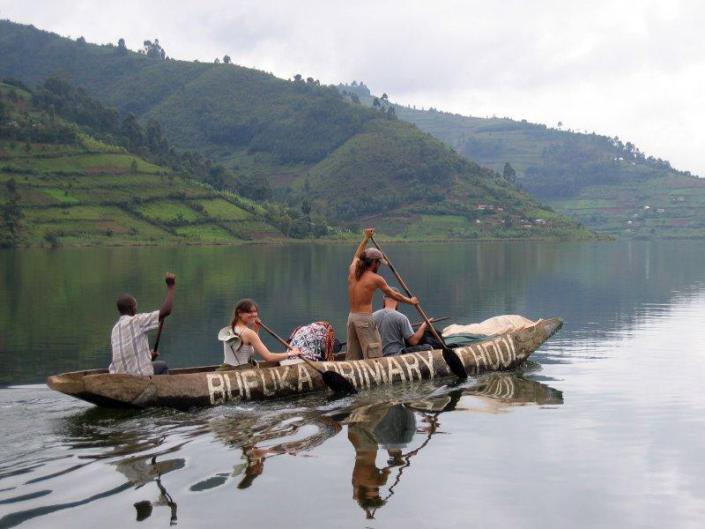
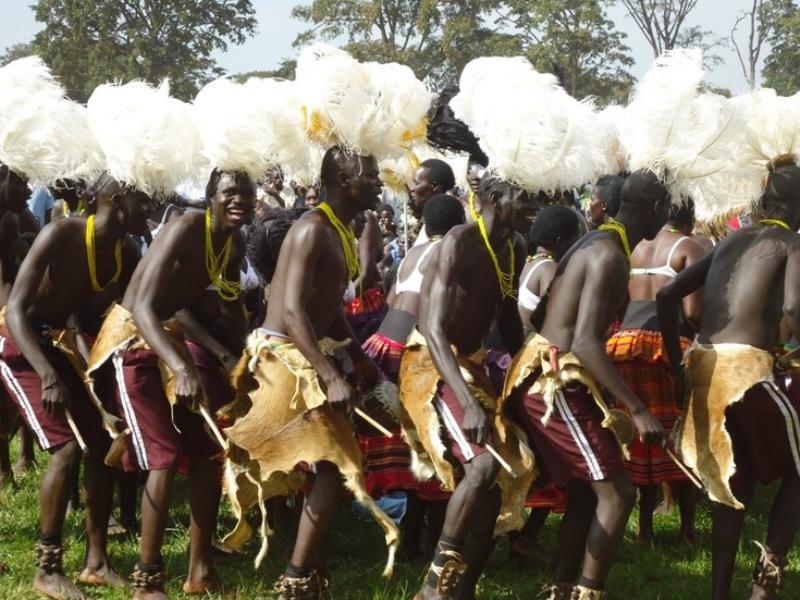
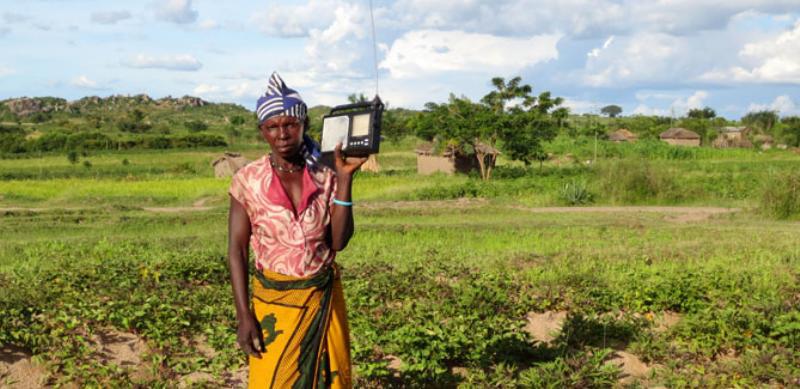
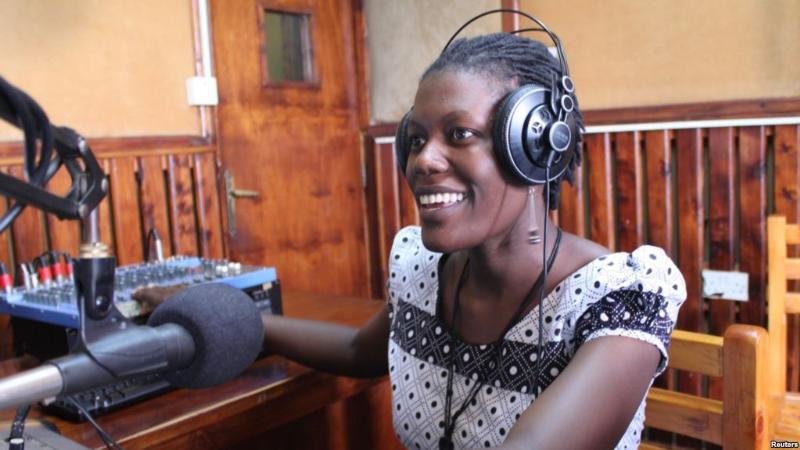

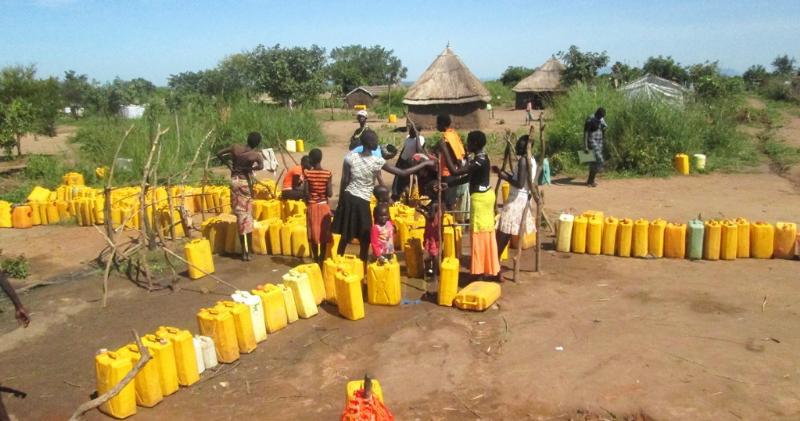

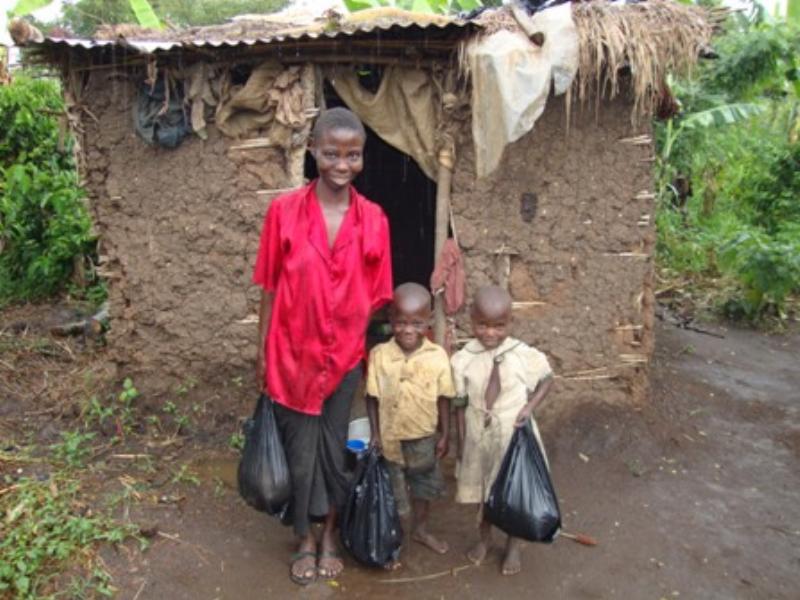
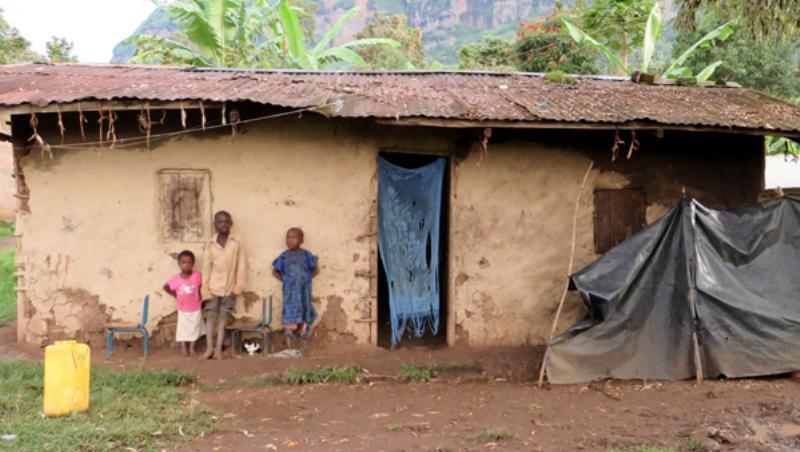
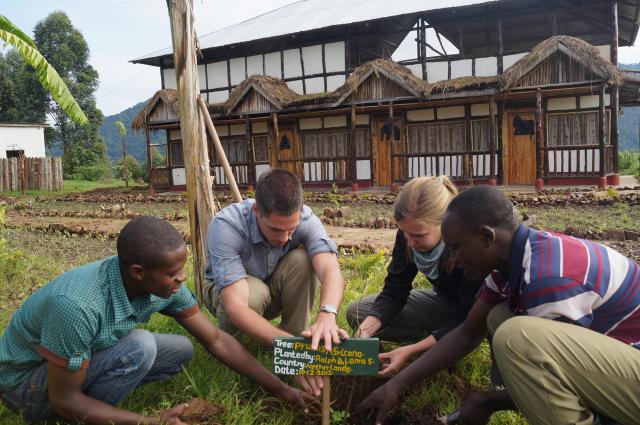 Every 5th of June is a day used by the United Nations to stimulate worldwide awareness of environmental issues and encourages political action.
Every 5th of June is a day used by the United Nations to stimulate worldwide awareness of environmental issues and encourages political action.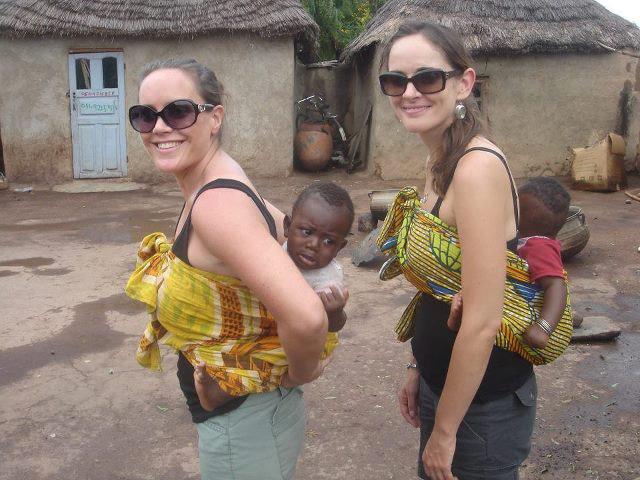
 The International Day of Friendship is a United Nations (UN) day that promotes the role that friendship plays in promoting peace in many cultures. To mark the International Day of Friendship, the UN encourages governments, organizations, and community groups to hold events, activities and initiatives that promote solidarity, mutual understanding and reconciliation.
The International Day of Friendship is a United Nations (UN) day that promotes the role that friendship plays in promoting peace in many cultures. To mark the International Day of Friendship, the UN encourages governments, organizations, and community groups to hold events, activities and initiatives that promote solidarity, mutual understanding and reconciliation. International Youth Day will be taking place on 12 August 2016, bringing youth issues to the attention of the international community and celebrating the potential of youth as partners in today’s global society.
International Youth Day will be taking place on 12 August 2016, bringing youth issues to the attention of the international community and celebrating the potential of youth as partners in today’s global society. Every time we travel, for whatever reason, we are part of a global movement; a movement that has the power to drive inclusive development, create jobs and build the sustainable societies we want for our future; a movement that builds mutual understanding and can help us safeguard our shared natural and cultural heritage.
Every time we travel, for whatever reason, we are part of a global movement; a movement that has the power to drive inclusive development, create jobs and build the sustainable societies we want for our future; a movement that builds mutual understanding and can help us safeguard our shared natural and cultural heritage.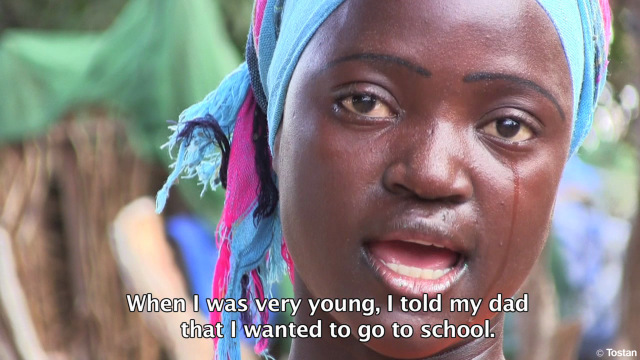 Girls are our future. This year, for the International Day of the Girl Child, on 11 October, we join global efforts to ensure a world free of discrimination for young women and girls.
Girls are our future. This year, for the International Day of the Girl Child, on 11 October, we join global efforts to ensure a world free of discrimination for young women and girls. World Food Day is a day of action against hunger. On October 16, people around the world come together to declare their commitment to eradicate hunger in our lifetime. Because when it comes to hunger, the only acceptable number in the world is zero. World Food Day has since then been observed in almost every country by millions of people.
World Food Day is a day of action against hunger. On October 16, people around the world come together to declare their commitment to eradicate hunger in our lifetime. Because when it comes to hunger, the only acceptable number in the world is zero. World Food Day has since then been observed in almost every country by millions of people.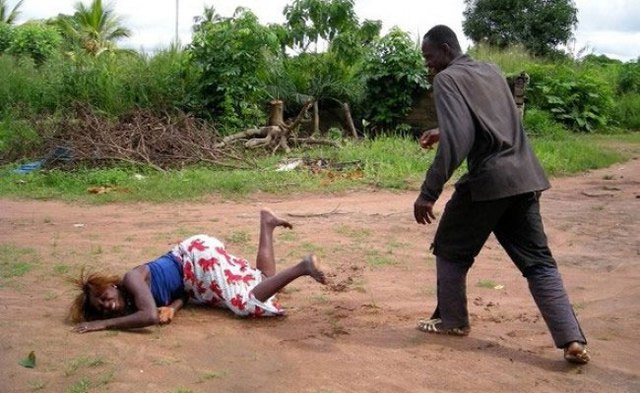
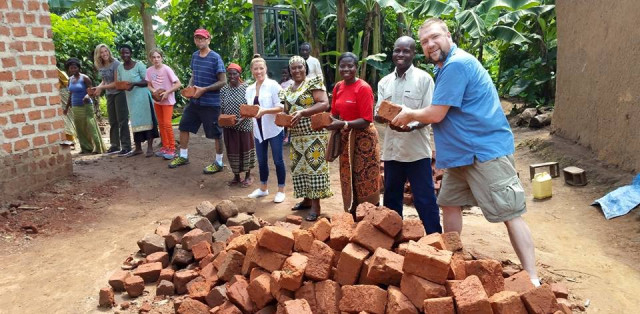 As an appreciation for voluntary engagement the United Nations have proclaimed 05 December, 2015 as the International Volunteer Day since 1986;
As an appreciation for voluntary engagement the United Nations have proclaimed 05 December, 2015 as the International Volunteer Day since 1986; 







 Every child has creative ability just waiting to be tapped. Majority Uganda children have untapped potential within themselves. Such children end up in unguided carriers which become unproductive for them in life. However, with the right educational play materials such as toys can bring it out.
Every child has creative ability just waiting to be tapped. Majority Uganda children have untapped potential within themselves. Such children end up in unguided carriers which become unproductive for them in life. However, with the right educational play materials such as toys can bring it out.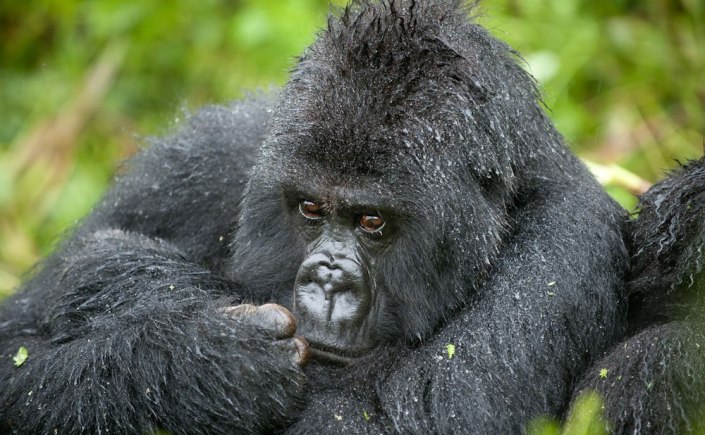












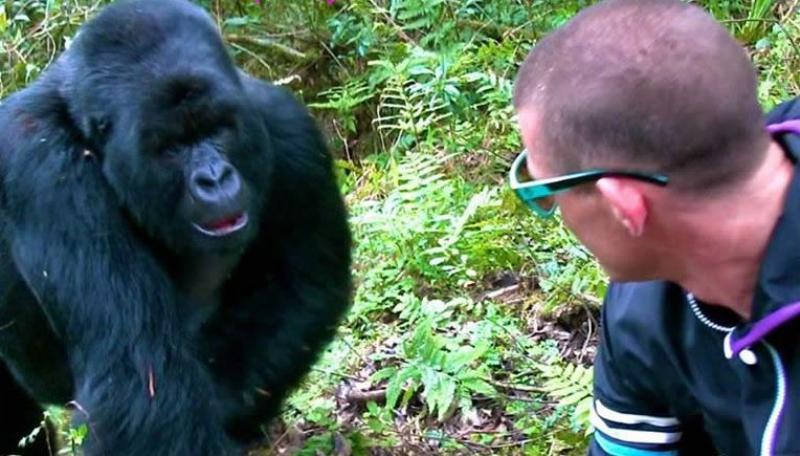

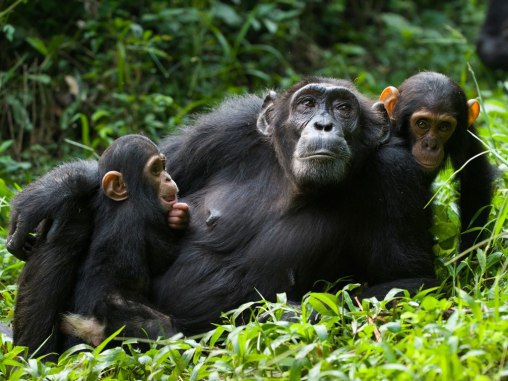
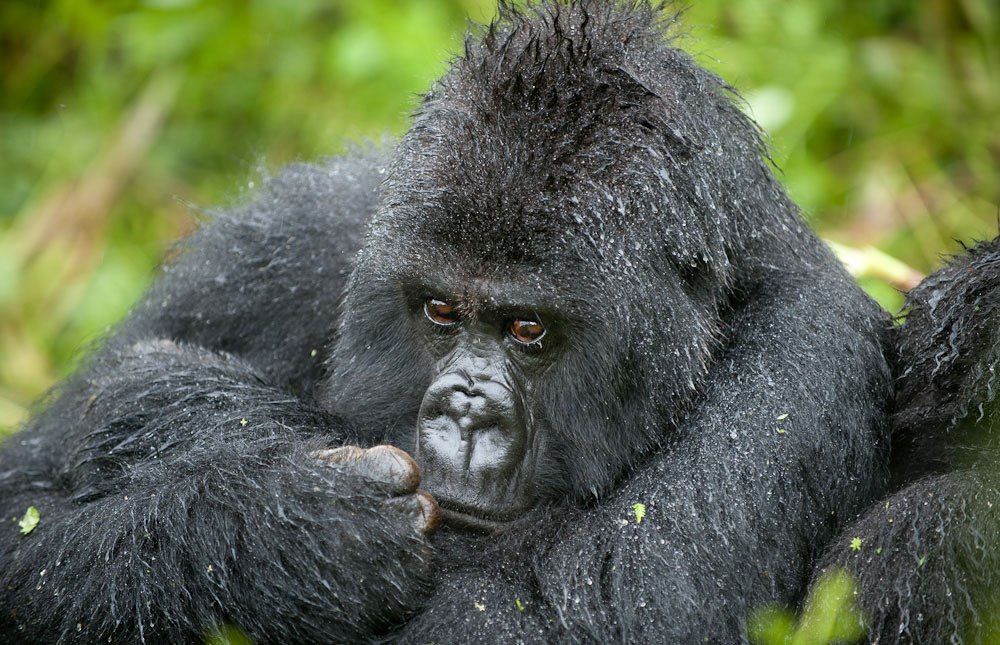
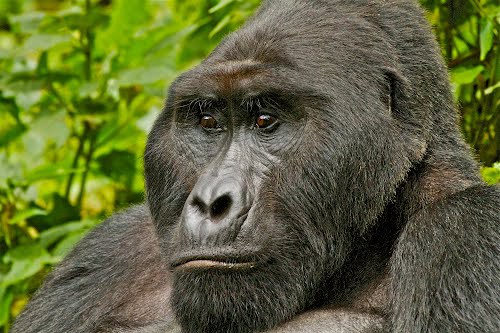




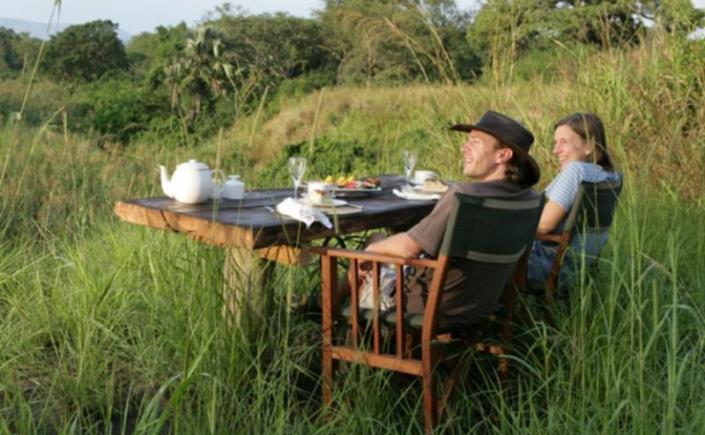







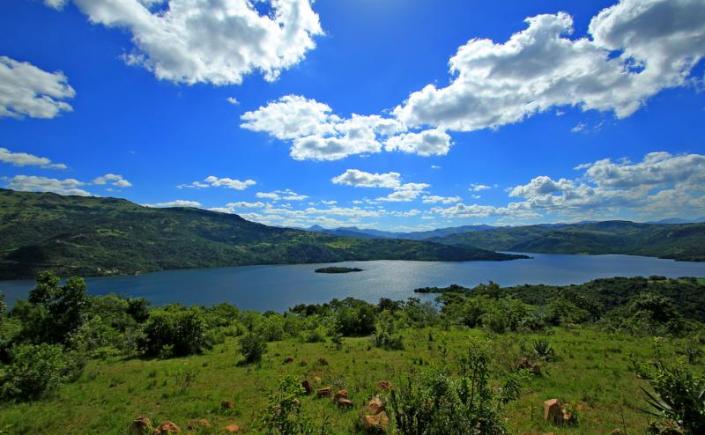

 Queen Elizabeth National park is one of the most interestingly beautiful destinations in the whole world! Rolling hills and valleys caress the savannah plains, speckled with acacia woodland before soaring inland to explosion craters, some with pure water lakes. The Launch Cruise along the famous Kazinga Channel, the Crater Lake drive and a nature walk to the Kyambura gorge and the blue lake, are the most thrilling experiences in this park. Our Kazinga channel launch cruise is the most luxurious in the western Uganda, plying these waters with comfort, elegance and attentive service, affording superb wildlife viewing from your observation deck, is far much re-assuring!
Queen Elizabeth National park is one of the most interestingly beautiful destinations in the whole world! Rolling hills and valleys caress the savannah plains, speckled with acacia woodland before soaring inland to explosion craters, some with pure water lakes. The Launch Cruise along the famous Kazinga Channel, the Crater Lake drive and a nature walk to the Kyambura gorge and the blue lake, are the most thrilling experiences in this park. Our Kazinga channel launch cruise is the most luxurious in the western Uganda, plying these waters with comfort, elegance and attentive service, affording superb wildlife viewing from your observation deck, is far much re-assuring!

















